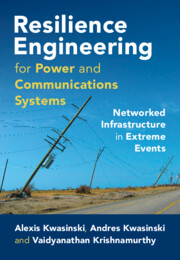 Resilience Engineering for Power and Communications Systems
Resilience Engineering for Power and Communications Systems Published online by Cambridge University Press: 04 January 2024
As was introduced in Chapter 1, adaptation is a fundamental attribute of resilient systems. Adaptation could occur by identifying changes in the physical and social environment with the potential to affect a community system operation or by reacting after a disruptive event happens. Part of a positive reaction in the latter of these adaptation mechanisms involves learning about which factors contributed to improving resilience and which factors caused a lower resilience. This chapter focuses on an important tool that is part of such a learning process for improved resilience: disaster forensics. Disaster forensics are based on a postdisaster investigation, in which field investigations and postevent data collection are important components. Hence, the first part of this chapter will focus on explaining the steps and procedures involved with a disaster forensic investigation, including a description of how to perform field investigations. This chapter then describes power grids’ and information and communication networks’ performance in recent natural disasters based on lessons obtained during past forensic investigations.
To save this book to your Kindle, first ensure no-reply@cambridge.org is added to your Approved Personal Document E-mail List under your Personal Document Settings on the Manage Your Content and Devices page of your Amazon account. Then enter the ‘name’ part of your Kindle email address below. Find out more about saving to your Kindle.
Note you can select to save to either the @free.kindle.com or @kindle.com variations. ‘@free.kindle.com’ emails are free but can only be saved to your device when it is connected to wi-fi. ‘@kindle.com’ emails can be delivered even when you are not connected to wi-fi, but note that service fees apply.
Find out more about the Kindle Personal Document Service.
To save content items to your account, please confirm that you agree to abide by our usage policies. If this is the first time you use this feature, you will be asked to authorise Cambridge Core to connect with your account. Find out more about saving content to Dropbox.
To save content items to your account, please confirm that you agree to abide by our usage policies. If this is the first time you use this feature, you will be asked to authorise Cambridge Core to connect with your account. Find out more about saving content to Google Drive.